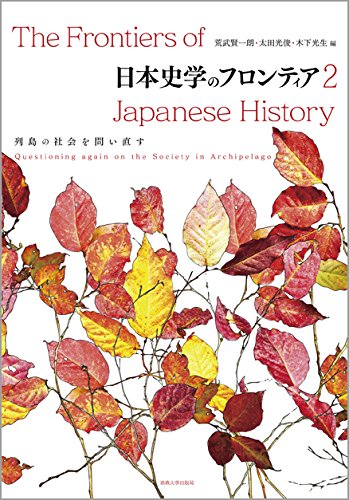- 著者
- 木下 光生
- 出版者
- 大阪歴史学会
- 雑誌
- ヒストリア = Historia : journal of Osaka Historical Association (ISSN:04392787)
- 巻号頁・発行日
- no.255, pp.106-113, 2016-04
2 0 0 0 列島の社会を問い直す
- 著者
- 荒武賢一朗 太田光俊 木下光生編
- 出版者
- 法政大学出版局
- 巻号頁・発行日
- 2015
1 0 0 0 OA 自己を発見する賤民と百姓
- 著者
- 木下 光生
- 出版者
- 国立歴史民俗博物館
- 雑誌
- 国立歴史民俗博物館研究報告 = Bulletin of the National Museum of Japanese History (ISSN:02867400)
- 巻号頁・発行日
- vol.169, pp.271-290, 2011-11-30
本稿は、日本の賤民と百姓が一八世紀後半~一九世紀以降、自他の身分を強く意識し出す状況を素材として、共同研究の全体テーマ「身体と人格をめぐる言説と実践」を、日本近世史研究において問うことの意義を考えるものである。本テーマは、これまでの近世史研究ではほとんど意識されてこなかったが、その問いを、自己の「客観的な実態」(身体)と「自己認識」(人格)の間に生ずるズレやせめぎ合いをめぐる問題に置き換えてみれば、近世史研究で残されている課題、とりわけ賤民と百姓の自他認識論として議論することが可能となる。そしてそうした視点にたつと、一八世紀後半~一九世紀という時代のもつ重要性が鮮やかに映し出されることとなる。通常、右の時代は、民衆の力によって身分(制)社会が「動揺」「崩壊(解体)」する時代として描かれがちである。だが、当該期の賤民や百姓が邁進した地位向上運動をつぶさに見てみると、当時の民衆が「身分」を相対化しようとしていたどころか、むしろそれにこだわりまくり、身分を拠り所にした自己表明を、運動によって公言して憚らない人びとであった点に気づかされる。しかもそれらの運動は、いずれも、他身分・他賤民との「平等」ではなく、「差別化」を図ろうとするものばかりであり、それに邁進すればするほど、本来複雑な実態をもつ「客観的な自己」と「自分が自覚する自己」をひたすら乖離・分裂させるものであった。こうした動向を、単に「限界」視するのは無意味であり、人びとが「身分」に寄り添おうとした切実な思いに、もっと肉迫し得るような発想と時代認識をもたなければならない。加えて、他者との「差別化」を孕むような地位向上運動は、近現代日本社会でも確認できる。その意味で、「身体と人格をめぐる言説と実践」という問いかけは、「前近代/近代」という既存の時間認識を相対化する可能性も秘めている。
1 0 0 0 IR 自己を発見する賤民と百姓 (身体と人格をめぐる言説と実践)
- 著者
- 木下 光生
- 出版者
- 国立歴史民俗博物館
- 雑誌
- 国立歴史民俗博物館研究報告 (ISSN:02867400)
- 巻号頁・発行日
- vol.169, pp.271-290, 2011-11
本稿は、日本の賤民と百姓が一八世紀後半~一九世紀以降、自他の身分を強く意識し出す状況を素材として、共同研究の全体テーマ「身体と人格をめぐる言説と実践」を、日本近世史研究において問うことの意義を考えるものである。本テーマは、これまでの近世史研究ではほとんど意識されてこなかったが、その問いを、自己の「客観的な実態」(身体)と「自己認識」(人格)の間に生ずるズレやせめぎ合いをめぐる問題に置き換えてみれば、近世史研究で残されている課題、とりわけ賤民と百姓の自他認識論として議論することが可能となる。そしてそうした視点にたつと、一八世紀後半~一九世紀という時代のもつ重要性が鮮やかに映し出されることとなる。通常、右の時代は、民衆の力によって身分(制)社会が「動揺」「崩壊(解体)」する時代として描かれがちである。だが、当該期の賤民や百姓が邁進した地位向上運動をつぶさに見てみると、当時の民衆が「身分」を相対化しようとしていたどころか、むしろそれにこだわりまくり、身分を拠り所にした自己表明を、運動によって公言して憚らない人びとであった点に気づかされる。しかもそれらの運動は、いずれも、他身分・他賤民との「平等」ではなく、「差別化」を図ろうとするものばかりであり、それに邁進すればするほど、本来複雑な実態をもつ「客観的な自己」と「自分が自覚する自己」をひたすら乖離・分裂させるものであった。こうした動向を、単に「限界」視するのは無意味であり、人びとが「身分」に寄り添おうとした切実な思いに、もっと肉迫し得るような発想と時代認識をもたなければならない。加えて、他者との「差別化」を孕むような地位向上運動は、近現代日本社会でも確認できる。その意味で、「身体と人格をめぐる言説と実践」という問いかけは、「前近代/近代」という既存の時間認識を相対化する可能性も秘めている。This paper focuses on how outcastes (senmin) and peasants (hyakusho) developed an awareness of their status identities and struggled to improve their status in Tokugawa Japan, especially from the late 18th century.Late Tokugawa Japan is usually described as a transitional period in which the existing status system (mibunsei) moved towards collapse under the pressure of ordinary people expressing mounting dissatisfaction with the status quo. However, a closer look at the rights movements of outcastes and peasants attempting to improve their status and protect their interests reveals that far from eroding the status system, their efforts actually tended to reaffirm it.For example, when sanmaihijiri tried to get rid of status prejudice against them, they appealed to the public to recognize their nobility and refrain from regarding them as outcastes like eta ( kawata) or hinin. Kawata too objected to being labelled as eta, claiming that they were actually peasants (kawata-hyakusho) and attempting to shift discrimination against them to other outcastes by describing those they saw as genuine eta or outcastes as beggars. Further, when peasants found themselves in confrontation with outcastes, especially with regard to agricultural interests, they often claimed that from the outset outcastes lacked both the right and qualifications to engage in agriculture.Although these people engaged in serious discussion about their identities, their views unfortunately did not match the reality. Not all outcastes were beggars ( while, in fact, some beggars were of peasant status) , and many outcastes had been engaged in agriculture for a long time. ( Recent studies show that the living standards of most outcastes were almost the same as those of peasants.) The above history of struggle to clarify status identities thus reveals bitter contradictions and dilemmas, with the rights movements creating an ever wider gap between subjective identity ( how people viewed their status and that of others) and objective identity ( actual status) .Clinging to a status system may seem like an old-fashioned, feudalistic attitude, but the fact is that similar movements have taken place in modern Japan too. As such, divisions such as "modern" and "pre-modern" (or feudalistic) are essentially meaningless, and we would do well to develop a new paradigm for thinking about historical time.
1 0 0 0 IR 村の「貧困」「貧農」と日本近世史研究 (鎌田道隆先生・佐々木克先生退職記念号)
- 著者
- 木下 光生
- 出版者
- 奈良大学史学会
- 雑誌
- 奈良史学 (ISSN:02894874)
- 巻号頁・発行日
- no.29, pp.95-123, 2011
近世日本の村社会における「貧困」や「貧農」の「実在」は、今なお、教科書でも一般向けの歴史書でも、「当たり前」のように説き続けられている。だが、ここで言う村や村人の「貧しさ」とは、いったい何を基準とした「貧しさ」なのであろうか。麻や木綿の服を着たり、雑穀を主食としたり、萱葺きの「粗末」な家に住むことが、なにゆえ「貧しい」ことなのか。「自給自足」の生活が、なぜ「貧しい暮らし」といえるのか。「富の偏在」がもたらした「極度の貧窮」とは、どのような生活実態を意味しているのか。本稿は、教科書におけるこの一見もっともらしい「村の貧しさ」の説明の仕方や、一般所で「所与の前提」とされる「貧農」の規程方法について、あらためて日本近世史研究(以下、近世史研究とする)におけるその研究史的経緯を整理し、村の「貧困」と「貧農」をめぐる研究現状と、今後の課題を検討するものである。
